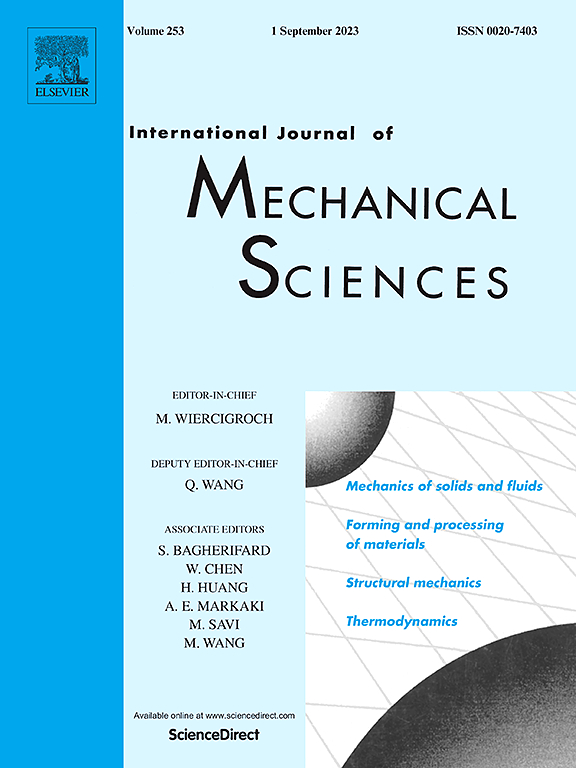非均质性对l-PBFed GF/PEEK复合材料热翘曲的影响
IF 7.1
1区 工程技术
Q1 ENGINEERING, MECHANICAL
International Journal of Mechanical Sciences
Pub Date : 2025-04-21
DOI:10.1016/j.ijmecsci.2025.110296
引用次数: 0
摘要
玻璃纤维增强聚醚醚酮(PEEK)复合材料的激光粉末床熔融(l-PBF)技术已成为航天器结构制造领域一种很有前途的材料选择。然而,在工程实践中,l-PBFed GF/PEEK复合材料的热翘曲是一个具有挑战性的问题。在本研究中,研究了非均质性对l-PBFed GF/PEEK复合材料热翘曲变形的影响。采用端部固定的薄壁条形试样进行热加载,模拟外板在外太空的受力约束。对l-PBFed GF/PEEK复合材料沿不同方向和不同纤维含量制备的热翘曲进行了比较,发现增加纤维含量和改善纤维排列可以缓解热翘曲问题。在此基础上,开发了一种将构件本构关系与微尺度有限元模型相结合的热翘曲模拟计算工具。通过测量l-PBFed PEEK的温度相关应力-应变曲线,评估了各组分的热本构关系。采用Tschogel屈服准则、非关联流动规则和Kriging代理模型对l-PBFed PEEK的热力学行为进行表征。采用微尺度重构算法建立了l-PBFed GF/PEEK复合材料的有限元模型。利用计算工具详细阐述了非均质性对l-PBFed GF/PEEK复合材料热翘曲的影响,为l-PBFed GF/PEEK复合材料的结构-性能关系提供了重要见解。本文章由计算机程序翻译,如有差异,请以英文原文为准。

Effect of heterogeneity on thermal warping of l-PBFed GF/PEEK composites
Glass fiber (GF) reinforced poly-ether-ether-ketone (PEEK) composites produced via laser powder bed fusion (l-PBF) have become a promising material option in the field of spacecraft structure manufacturing. However, the thermal warping of l-PBFed GF/PEEK composites is found to be a challenging issue in engineering practice. In the present study, the effect of heterogeneity on thermal warping deformation of l-PBFed GF/PEEK composites is investigated for space applications. Thin-wall strip specimens with fixed ends are subjected to thermal loading to simulate the constraints experienced by external plates in outer space. The thermal warping of l-PBFed GF/PEEK composites fabricated along different directions and with varying fiber contents are compared, revealing that increased fiber content and improved fiber alignment could mitigate the issue of thermal warping. Further, a computational tool integrating the constitutive relations of the constituents with micro-scale finite element analysis (FEA) models is developed for thermal warping simulation. The thermal constitutive relations of the constituents are assessed, with temperature-dependent stress-strain curves measured for l-PBFed PEEK. The thermal mechanical behavior of l-PBFed PEEK is characterized using the Tschogel’s yield criterion, a non-associated flow rule, and a Kriging surrogate model. The FEA models of l-PBFed GF/PEEK composites are established using a micro-scale reconstruction algorithm. The effect of heterogeneity on the thermal warping of l-PBFed GF/PEEK composites is elaborated using the computational tool, providing critical insights into the structure-property relationships of l-PBFed GF/PEEK composites.
求助全文
通过发布文献求助,成功后即可免费获取论文全文。
去求助
来源期刊

International Journal of Mechanical Sciences
工程技术-工程:机械
CiteScore
12.80
自引率
17.80%
发文量
769
审稿时长
19 days
期刊介绍:
The International Journal of Mechanical Sciences (IJMS) serves as a global platform for the publication and dissemination of original research that contributes to a deeper scientific understanding of the fundamental disciplines within mechanical, civil, and material engineering.
The primary focus of IJMS is to showcase innovative and ground-breaking work that utilizes analytical and computational modeling techniques, such as Finite Element Method (FEM), Boundary Element Method (BEM), and mesh-free methods, among others. These modeling methods are applied to diverse fields including rigid-body mechanics (e.g., dynamics, vibration, stability), structural mechanics, metal forming, advanced materials (e.g., metals, composites, cellular, smart) behavior and applications, impact mechanics, strain localization, and other nonlinear effects (e.g., large deflections, plasticity, fracture).
Additionally, IJMS covers the realms of fluid mechanics (both external and internal flows), tribology, thermodynamics, and materials processing. These subjects collectively form the core of the journal's content.
In summary, IJMS provides a prestigious platform for researchers to present their original contributions, shedding light on analytical and computational modeling methods in various areas of mechanical engineering, as well as exploring the behavior and application of advanced materials, fluid mechanics, thermodynamics, and materials processing.
 求助内容:
求助内容: 应助结果提醒方式:
应助结果提醒方式:


